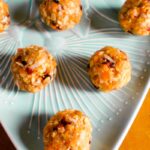Dive into the delightful world of dairy-free yogurt parfaits! This guide unveils the secrets to crafting creamy, layered delights bursting with flavor and texture, all without relying on dairy products. We’ll explore a variety of dairy-free yogurt alternatives, from the rich creaminess of coconut yogurt to the subtle nuttiness of almond, guiding you through homemade options and showcasing their unique properties in parfait construction. Prepare to embark on a culinary journey filled with vibrant fruit combinations, crunchy nuts, and satisfyingly sweet treats.
Learn to master the art of parfait layering, transforming simple ingredients into visually stunning and incredibly delicious desserts. Discover how different layering techniques impact both the aesthetic appeal and the overall sensory experience, creating a harmonious blend of textures and tastes with each spoonful. We’ll provide adaptable recipes, catering to various dietary needs and preferences, ensuring that everyone can enjoy the joy of a perfectly crafted dairy-free yogurt parfait.
Dairy-Free Yogurt Alternatives

Creating delicious and healthy dairy-free yogurt parfaits starts with choosing the right base. Several excellent dairy-free yogurt alternatives exist, each boasting a unique flavor profile and texture. Understanding their nutritional differences will help you select the perfect option for your parfait creation.
Dairy-Free Yogurt Comparison
The following table provides a nutritional and textural comparison of popular dairy-free yogurt options. Note that nutritional values can vary depending on the brand and specific ingredients used.
| Yogurt Type | Nutritional Profile (per serving, approximate) | Texture | Advantages in Parfaits |
|---|---|---|---|
| Coconut Yogurt | High in saturated fat, good source of probiotics (depending on brand), may contain added sugar | Thick, creamy, sometimes slightly sweet | Provides a rich, decadent base; pairs well with tropical fruits and granola. |
| Almond Yogurt | Low in calories, good source of vitamin E, often fortified with calcium and vitamin D | Generally thinner than coconut yogurt, can be slightly watery | Lighter option; complements lighter fruits and nuts. |
| Soy Yogurt | Good source of protein, often fortified with calcium and vitamin D, may contain isoflavones | Texture varies widely depending on brand; can range from creamy to slightly grainy | Versatile; works well with a variety of toppings. High protein content adds satiety. |
| Cashew Yogurt | High in healthy fats, good source of magnesium and zinc | Very creamy and smooth, often naturally sweet | Luxurious and decadent; pairs beautifully with berries and chocolate. |
Homemade Coconut Yogurt
Making coconut yogurt at home allows for complete control over ingredients and sweetness. Begin by sourcing full-fat coconut milk (look for cans with minimal added ingredients). The creamier the coconut milk, the creamier the yogurt will be. You’ll also need a probiotic starter culture; these are readily available online or in health food stores. Many use a commercially available yogurt starter, while others prefer a more hands-on approach using a small amount of live, active culture yogurt as a starter.
The fermentation process involves gently warming the coconut milk to around 110-115°F (43-46°C) – this temperature is crucial for activating the probiotic cultures without killing them. Once warmed, carefully stir in the probiotic starter culture. Pour the mixture into sterilized jars, cover loosely, and incubate in a warm place (around 80-85°F or 27-29°C) for 12-24 hours, or until the yogurt has thickened to your desired consistency. Refrigerate for at least 4 hours to halt fermentation and enhance the yogurt’s texture. The final product will have a subtly tangy flavor and a luxuriously creamy texture. The color will be a beautiful off-white, mirroring the creamy hue of the coconut milk.
Advantages and Disadvantages of Dairy-Free Yogurts in Parfaits
Each dairy-free yogurt offers unique advantages and disadvantages when used as a parfait base. Coconut yogurt, for example, provides a rich and creamy texture, perfectly complementing tropical fruits. However, its high saturated fat content should be considered. Almond yogurt, with its lighter texture and lower calorie count, is a healthier option but may lack the same richness. Soy yogurt’s versatility makes it a good all-around choice, while cashew yogurt offers a decadent creaminess that pairs exceptionally well with chocolate and berries. The choice ultimately depends on individual preferences and dietary needs.
Parfait Layer Ingredients and Combinations
Building the perfect dairy-free yogurt parfait is all about layering textures and flavors to create a delightful sensory experience. The key is to balance creamy yogurt with crunchy elements and bursts of sweetness and acidity. Careful consideration of ingredient combinations will lead to a truly satisfying and healthy treat.
The possibilities for creating unique and delicious dairy-free yogurt parfaits are virtually endless. By thoughtfully combining various ingredients, you can craft a parfait that perfectly suits your taste preferences and dietary needs. This section will explore a wide array of options, providing inspiration for your own culinary creations.
Dairy-Free Yogurt Parfait Layer Ideas
The following list provides a diverse range of ingredients to inspire your parfait creations. Remember to consider flavor profiles and textural contrasts when selecting your components. Experiment with different combinations to discover your personal favorites.
- Dairy-Free Yogurts: Coconut yogurt, almond yogurt, cashew yogurt, soy yogurt, oat yogurt (consider plain or flavored varieties).
- Fruits: Berries (strawberries, blueberries, raspberries, blackberries), bananas, mango, peaches, pineapple, kiwi, apples (consider fresh, frozen, or lightly cooked).
- Nuts: Almonds, walnuts, pecans, cashews, pistachios (consider slivered, chopped, or whole).
- Seeds: Chia seeds, flax seeds, hemp seeds, pumpkin seeds, sunflower seeds (consider toasted or untoasted).
- Sweeteners: Honey, maple syrup, agave nectar, dates (consider pureed or chopped).
- Other additions: Granola, shredded coconut, cacao nibs, cocoa powder, cinnamon, nutmeg, vanilla extract.
Three Unique Dairy-Free Parfait Recipes
These recipes showcase the versatility of dairy-free yogurt parfaits by highlighting distinct flavor profiles and ingredient combinations.
- Tropical Mango Coconut Parfait:
- Layer 1: 1/2 cup creamy coconut yogurt
- Layer 2: 1/2 cup diced fresh mango
- Layer 3: 1 tablespoon shredded coconut
- Layer 4: 1 tablespoon toasted slivered almonds
- Layer 5: 1 teaspoon honey
- Repeat layers 1-5.
Flavor Profile: Sweet, tropical, and subtly nutty. The creamy coconut yogurt complements the juicy mango, while the toasted almonds add a delightful crunch.
- Berry Almond Crunch Parfait:
- Layer 1: 1/2 cup almond yogurt
- Layer 2: 1/2 cup mixed berries (strawberries, blueberries, raspberries)
- Layer 3: 1 tablespoon granola
- Layer 4: 1 tablespoon chopped almonds
- Layer 5: 1/2 teaspoon maple syrup
- Repeat layers 1-5.
Flavor Profile: Tart, sweet, and crunchy. The almond yogurt provides a subtly nutty base, which is beautifully balanced by the sweetness of the berries and the satisfying crunch of the granola and almonds.
- Apple Cinnamon Oat Parfait:
- Layer 1: 1/2 cup oat yogurt
- Layer 2: 1/2 cup diced apple (lightly sautéed with cinnamon)
- Layer 3: 1 tablespoon chia seeds
- Layer 4: 1/2 teaspoon cinnamon
- Layer 5: 1 tablespoon maple syrup
- Repeat layers 1-5.
Flavor Profile: Warm, comforting, and subtly spiced. The oat yogurt offers a creamy texture, while the sautéed apples and cinnamon create a cozy autumnal flavor. The chia seeds add a pleasant textural contrast and nutritional boost.
Nutritional Information (Approximate Values per Parfait)
Note: Nutritional values are estimates and may vary based on specific brands and ingredients used. These values are calculated using online nutritional calculators and are not a substitute for professional nutritional advice.
| Parfait Type | Calories | Protein (g) | Fat (g) | Carbohydrates (g) | Fiber (g) |
|---|---|---|---|---|---|
| Tropical Mango Coconut | 350-400 | 8-10 | 20-25 | 40-50 | 5-7 |
| Berry Almond Crunch | 300-350 | 7-9 | 15-20 | 35-45 | 4-6 |
| Apple Cinnamon Oat | 280-320 | 6-8 | 10-15 | 45-55 | 6-8 |
Storage and Serving Suggestions
Creating delicious dairy-free yogurt parfaits is only half the battle; preserving their vibrant flavors and textures is just as crucial. Proper storage ensures your creations remain delightful, whether enjoyed immediately or saved for later. Serving suggestions can elevate the simple parfait into a truly memorable culinary experience.
Proper storage significantly impacts the longevity and quality of your homemade dairy-free yogurt parfaits. The key is to maintain a cool, consistent temperature and prevent unwanted moisture or air exposure. For optimal freshness, individual parfaits should be stored in airtight containers, ideally glass, to prevent freezer burn if freezing. Layers may separate slightly upon thawing; gently stir before serving.
Parfait Storage Methods
Storing your parfaits correctly is essential for maintaining their freshness and preventing spoilage. Refrigeration is the best method for short-term storage (1-3 days). For longer storage (up to a month), freezing is an option. However, some textural changes may occur upon thawing.
- Refrigeration: Store individual parfaits in airtight containers in the refrigerator at 40°F (4°C) or below. This method preserves the creamy texture and prevents the yogurt from becoming watery.
- Freezing: For longer storage, assemble parfaits in individual freezer-safe containers, leaving a little headspace for expansion. Freezing can slightly alter the texture of the yogurt and some fruits, making them slightly softer upon thawing. Gently stir the parfait after thawing to reintegrate the layers.
Ideal Serving Temperatures and Accompaniments
Serving temperature and complementary beverages greatly enhance the overall parfait experience. A chilled parfait offers a refreshing contrast to warmer temperatures, while room temperature parfaits provide a different textural experience. Careful consideration of complementary beverages enhances the overall sensory delight.
- Serving Temperature: Chilled parfaits are generally preferred for their refreshing quality, especially during warmer months. However, room temperature parfaits can offer a different, more mellow flavor profile. Experiment to discover your preference.
- Beverage Pairings: A light, crisp beverage complements the sweetness of the parfait. Consider unsweetened iced tea, sparkling water with a squeeze of citrus, or even a light fruit juice (avoiding anything too acidic that might curdle the yogurt). A warm herbal tea, such as chamomile or peppermint, can also be a pleasant contrast to the cool parfait, particularly in colder weather.
Preparing Parfaits Ahead for Gatherings
Preparing parfaits ahead of time for parties or gatherings simplifies hosting. The key is to assemble the layers separately and combine just before serving. This prevents the granola from becoming soggy and maintains the visual appeal of the layered parfait.
To prepare ahead, layer the dairy-free yogurt in individual serving glasses or containers. Separately store the granola and fruit in airtight containers in the refrigerator. Just before serving, gently spoon the granola and fruit over the yogurt layers, creating your visually stunning and delicious parfaits. This method ensures each guest receives a fresh, appealing parfait.
Creating dairy-free yogurt parfaits at home is not just about assembling ingredients; it’s about crafting a personalized culinary experience. From the careful selection of dairy-free yogurt bases to the creative layering of fruits, nuts, and seeds, each parfait tells a story of flavor and texture. This guide has equipped you with the knowledge and recipes to embark on this delightful journey, empowering you to customize your parfaits to reflect your unique preferences and dietary needs. So, gather your ingredients, unleash your creativity, and savor the rewarding taste of homemade perfection!
Popular Questions
Can I make the parfaits ahead of time?
Yes, assemble the parfaits without the fruit toppings up to a day in advance. Store them covered in the refrigerator. Add the fresh fruit just before serving to maintain optimal freshness and texture.
What if my dairy-free yogurt is too thin?
Thicker yogurts are ideal for parfaits. If your yogurt is thin, you can thicken it by straining it through cheesecloth for a few hours or overnight. Alternatively, you can incorporate chia seeds or flaxseed meal to increase its viscosity.
How long can I store the homemade dairy-free yogurt?
Homemade dairy-free yogurt, especially coconut yogurt, can last for about 5-7 days in the refrigerator when properly stored in an airtight container.
Are there any substitutes for sweeteners?
Yes, you can adjust the sweetness according to your preference. Maple syrup, agave nectar, or even a touch of stevia can be used as substitutes for the sweeteners mentioned in the recipes.


